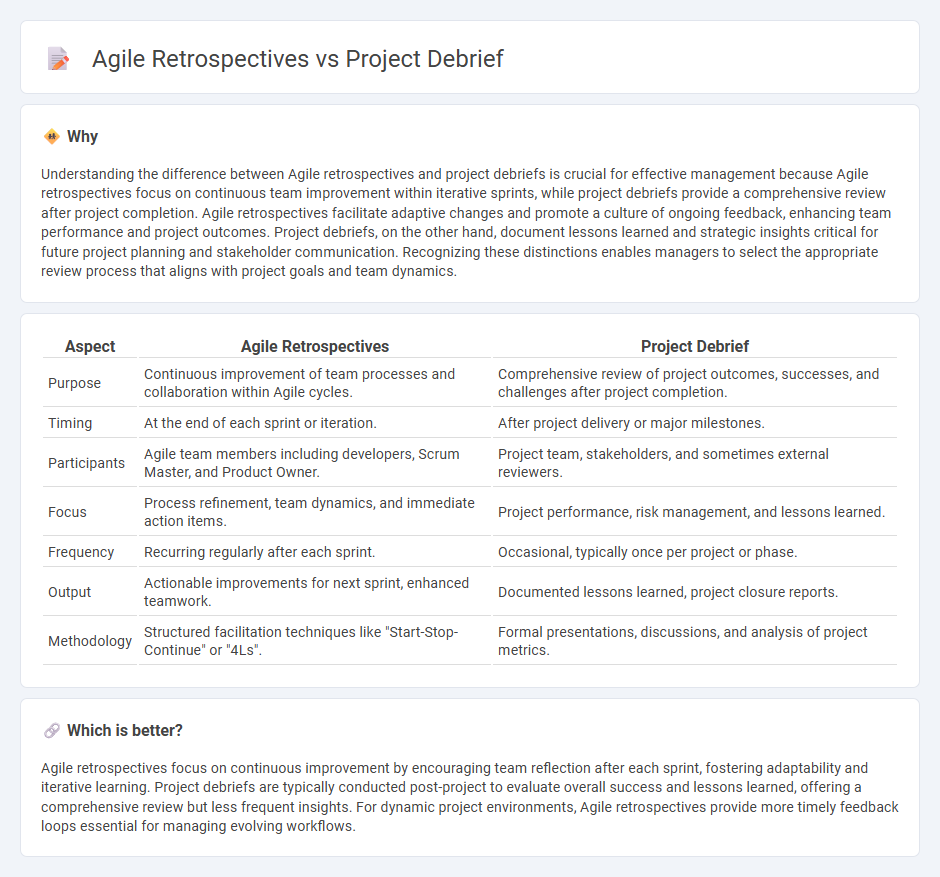
Agile retrospectives focus on iterative team feedback to improve upcoming sprints, emphasizing continuous learning and adaptability within agile frameworks like Scrum or Kanban. Project debriefs analyze the overall project lifecycle, assessing successes, challenges, and lessons learned after project completion to enhance future project management strategies. Explore how these methods optimize team performance and project outcomes in dynamic environments.
Why it is important
Understanding the difference between Agile retrospectives and project debriefs is crucial for effective management because Agile retrospectives focus on continuous team improvement within iterative sprints, while project debriefs provide a comprehensive review after project completion. Agile retrospectives facilitate adaptive changes and promote a culture of ongoing feedback, enhancing team performance and project outcomes. Project debriefs, on the other hand, document lessons learned and strategic insights critical for future project planning and stakeholder communication. Recognizing these distinctions enables managers to select the appropriate review process that aligns with project goals and team dynamics.
Comparison Table
| Aspect | Agile Retrospectives | Project Debrief |
|---|---|---|
| Purpose | Continuous improvement of team processes and collaboration within Agile cycles. | Comprehensive review of project outcomes, successes, and challenges after project completion. |
| Timing | At the end of each sprint or iteration. | After project delivery or major milestones. |
| Participants | Agile team members including developers, Scrum Master, and Product Owner. | Project team, stakeholders, and sometimes external reviewers. |
| Focus | Process refinement, team dynamics, and immediate action items. | Project performance, risk management, and lessons learned. |
| Frequency | Recurring regularly after each sprint. | Occasional, typically once per project or phase. |
| Output | Actionable improvements for next sprint, enhanced teamwork. | Documented lessons learned, project closure reports. |
| Methodology | Structured facilitation techniques like "Start-Stop-Continue" or "4Ls". | Formal presentations, discussions, and analysis of project metrics. |
Which is better?
Agile retrospectives focus on continuous improvement by encouraging team reflection after each sprint, fostering adaptability and iterative learning. Project debriefs are typically conducted post-project to evaluate overall success and lessons learned, offering a comprehensive review but less frequent insights. For dynamic project environments, Agile retrospectives provide more timely feedback loops essential for managing evolving workflows.
Connection
Agile retrospectives and project debriefs both focus on continuous improvement by analyzing project performance and team dynamics to identify actionable insights. Agile retrospectives specifically occur at the end of each sprint, emphasizing iterative feedback loops, while project debriefs usually happen after project completion to evaluate overall success and challenges. Integrating findings from both processes enhances organizational learning and optimizes future project management efficiency.
Key Terms
Project debrief:
Project debriefs provide a structured evaluation of project outcomes, focusing on achievements, challenges, and lessons learned for future improvements. They emphasize detailed analysis of project phases, stakeholder feedback, and resource management to optimize performance. Discover in-depth strategies to conduct effective project debriefs and enhance project success.
Lessons Learned
Project debrief sessions capture comprehensive Lessons Learned at project closure, emphasizing evaluation of outcomes, stakeholder feedback, and process efficiency. Agile retrospectives occur regularly within iterations, targeting continuous improvement by analyzing team dynamics, workflow obstacles, and actionable adjustments. Explore detailed strategies to maximize Lessons Learned in both methodologies and enhance project success.
Post-Implementation Review
Project debriefs analyze overall outcomes, lessons learned, and stakeholder feedback after project completion, emphasizing performance against objectives and deliverables. Agile retrospectives prioritize continuous improvement through team reflection on processes and collaboration during iterations, fostering adaptive change. Explore deeper insights into post-implementation reviews to enhance project outcomes and team efficiency.
Source and External Links
How to Conduct a Project Debrief - A project debrief is a meeting held after project completion where teams review and analyze outcomes, assign actionable takeaways, and document key insights to improve future projects, with steps including scheduling, assigning roles, distributing surveys, and preparing an agenda.
Tips for a Successful Debrief Meeting (+ Template) - Debrief meetings are structured conversations post-project to review goals and achievements, analyze challenges, extract lessons learned, plan future actions, and assess teamwork and communication.
The Power of Project Debriefs - MBB Agency - Project debriefs identify successes and challenges, develop actionable steps, document and share findings with leadership and teams, implement process improvements, and monitor changes for ongoing effectiveness.
 dowidth.com
dowidth.com